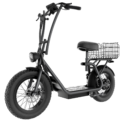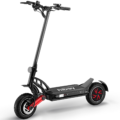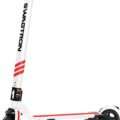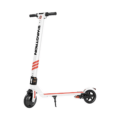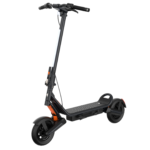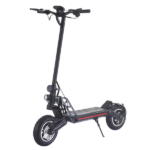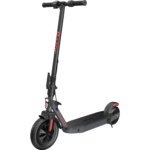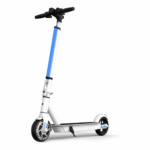- Home
- Scooters
- Electric Scooters
- Hiboy S2R Plus
Hiboy S2R Plus
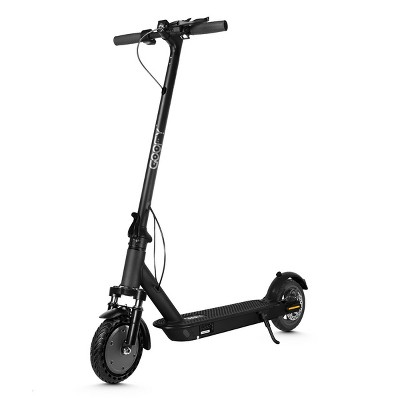


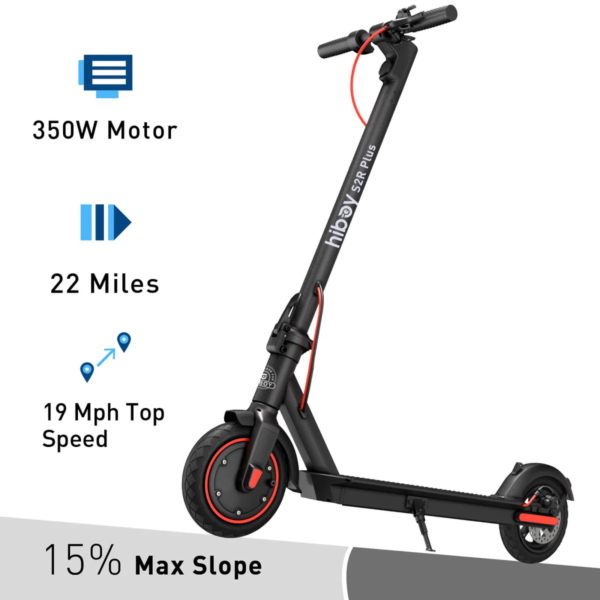
- Battery Range: 22 miles (≈35 km)
- Top Speed: 19 mph (≈30 km/h)
- Motor Power: 350 W rated
- Weight Capacity: 100 kg (220 lb)
- Charging Time: ~5–6 hours
- Scooter Weight & Portability: ~31.5 lb (14.3 kg)
PROS
- Lightweight and easy to fold & carry
- Removable battery for flexible charging
- Cruise control via app or throttle
- Pneumatic tires and rear suspension for smooth rides
- Bright lights and visible safety features
CONS
- No front suspension
- Shorter range requires frequent charging
- Fixed handlebar may not suit all heights

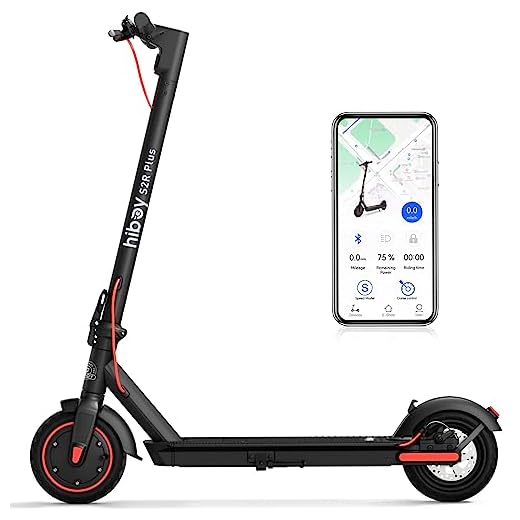
Hiboy S2R Plus Overview
Easy Start, Lightweight Design
The Hiboy S2R Plus stands out as a light, user-friendly commuter scooter. Weighing only 31.5 lb (14.3 kg), it’s easy to fold, lift, and store in tight spaces—perfect for city dwellers or students. Despite its compact design, it feels substantial yet agile when riding. The sturdy aluminum frame resists wobbling and gives a durable feel that often surprises first-time riders.
The folding mechanism works in three simple steps. Lift the latch, fold, and secure with a rear hook. Thanks to its compact folded size—44.1 × 16.9 × 49.2 in—it fits in car trunks, closets, or hallways without hassle. While it’s not the lightest scooter in the market, most users find its weight manageable for occasional carrying.
Solid Power and Rider-Friendly Range
This scooter uses a 350 W rated motor, bursting up to 500 W when needed. It hits its top speed of 19 mph smoothly on flat terrain. That’s enough to comfortably navigate fast bike lanes without feeling laggy. It keeps pace well with urban traffic while still staying compliant in many local jurisdictions and being safe for casual riders.
For everyday commutes, the Hiboy S2R Plus delivers up to 22 miles (35 km) of real-world range on its 313 Wh battery. Most users working 10–15 km commutes will find they only need to charge every few days. Plus, its removable battery adds flexibility—you can swap it with a spare or charge indoors while the scooter stays outside or locked up. The smart BMS prevents overheating and overcharging, helping the battery stay healthy over time.
Ride Comfort Without the Bulk
Despite skipping heavy suspension systems, the S2R Plus saves comfort with 9″ pneumatic tires and dual rear suspension. These two work together to soften ride bumps, making city rides smoother than solid-tire scooters. Riders notice less vibration in their feet and better traction on wet surfaces.
The deck measures about 18.9 inches by 5.9 inches—compact, but spacious enough for a comfortable two-foot stance. The upright fixed handlebars and a balanced weight distribution complete a ride posture that feels natural and free from strain on longer trips.
Safety Features for Confident Commuting
Safety isn’t an afterthought. The combination of front E-brake and rear mechanical disc stops the scooter quickly and smoothly. The E-brake activates gently, while the rear brake gives extra stopping control. This works well in tight traffic or sudden stops.
Visibility is solid too. The front LED headlight brightens the path, making low-light rides safer. Side reflectors and the responsive rear LED light bring awareness from behind. The lighting setup is easy to control with the console or app—a nice touch that combines safety with convenience.
Smart App Integration and Cruise Control
The Hiboy app gives you much more than basic control—it lets you lock the motor, set speed limits, track riding stats, and toggle cruise control. Once you reach your desired speed, a few seconds on the throttle activates cruise mode, keeping you at a steady pace without thumb fatigue. This is a thoughtful addition, especially for daily commuters.
App control also lets you switch between modes, adjust lighting, and monitor battery life—all from your phone. That level of control in this price tier feels advanced, offering more flexibility than many basic models.
Practical Use Case Scenarios
The S2R Plus serves several practical purposes:
- Daily Commutes — efficient and simple for regular short-distance travel
- Errand Runs — gives room for quick trips to local shops
- Campus Life — lightweight and foldable for dorm and classroom mobility
- Leisure Rides — cruise control and soft tires make weekend rides enjoyable
- App-Savvy Users — enjoy tech features without breaking the bank
If you’re looking for longer range, check out the Hiboy S2 Max. If you want a mid-range step with slightly longer range and solid build, also see the Hiboy S2 Pro for comparison.
Potential Trade-Offs
Every scooter has trade-offs:
- No suspension at the front means rough roads can jostle riders more than fully suspended models.
- 22 miles range is ideal for urban use only—longer trips require frequent charging or spare battery.
- The fixed handlebar height might not suit taller riders seeking more ergonomic control.
- Heavier than bare-bones commuter models, though balanced for most users.
Final Verdict
The Hiboy S2R Plus impresses as a full-featured, budget-friendly commuter scooter. It delivers real-world range, a smooth ride feel, solid build quality, and modern app-driven features like cruise control and motor lock. While it doesn’t chase top-end specs, it offers a reliable riding experience for everyday use. It stands out in its class for its value, balance, and smart simplicity.
If you’re looking for a light, user-friendly commuter that covers the essentials and a few thoughtful extras, the S2R Plus hits the mark.
Specifications
General
| Model The Model specifies the exact version or name of the scooter. It helps identify its unique design, features, and specifications within the manufacturer’s product line. Knowing the model makes it easier to compare options, find compatible accessories, or look up support information. | S2R Plus |
| Brand The Brand identifies the manufacturer or company that designs and produces the scooter. A trusted brand is a sign of quality, reliability, and good customer support. Well-known brands often have higher standards for safety, performance, and after-sales service, giving you more confidence in your purchase. | Hiboy |
| Release Date The Release Date indicates when the scooter model was officially launched on the market. This helps you know how current the design, technology, and features are. A newer release date often means updated components, improved performance, and the latest safety or smart features. | 01 January 2023 |
| Recommended Age Recommended Age indicates the minimum age range that the scooter is designed for, based on safety, size, and ease of use. Following the recommended age helps ensure that riders can handle the scooter’s speed, weight, and controls comfortably and safely. Always check local laws and use protective gear, especially for younger riders. | 16+ years |
Performance & Power
| Motor Power (Wattage) What it means: The motor power, measured in watts (W), shows how strong the scooter’s electric motor is. Why it matters: Higher wattage usually means better acceleration, more torque, and improved performance on hills or rough terrain. For example, a 250W motor is good for flat city roads and light riders, while a 500W or 1000W motor provides more power for faster speeds or climbing steep inclines. | 350 W rated, 500 W peak |
| Top Speed The Top Speed indicates the maximum speed that the scooter can reach under optimal conditions. It’s usually measured on level ground with a fully charged battery and an average rider weight. A higher top speed allows you to travel longer distances faster, but always ensure you ride within legal speed limits and your personal comfort zone for safety. | 19 mph (≈30 km/h) |
| Battery Capacity Battery Capacity refers to the total amount of energy the scooter’s battery can store, usually measured in ampere-hours (Ah) or watt-hours (Wh). A higher battery capacity means you can ride longer distances on a single charge, reducing the need for frequent recharging. Keep in mind that actual range can vary depending on rider weight, terrain, speed, and weather conditions. | 36 V, 8.7 Ah (~313 Wh), detachable |
| Estimated Range per Charge The Estimated Range per Charge indicates the average distance the scooter can travel on a single full battery charge. This range is calculated under optimal conditions, such as flat terrain, moderate speed, and average rider weight. Real-world range may vary depending on riding style, terrain, weather, and load. A longer range means fewer recharges and greater freedom for longer trips. | Up to 22 miles (≈35 km) |
| Hill Climb Ability Hill Climb Ability describes the maximum incline or slope that the scooter can handle while maintaining stable performance. It’s typically expressed as a percentage or in degrees. A higher hill climb rating means the scooter can tackle steeper hills without losing too much speed or power. Actual climbing performance may vary based on rider weight, battery charge, and terrain conditions. | Up to ~15° incline |
| Drive System The Drive System refers to how power from the motor is delivered to the wheels. Electric scooters typically use either a hub motor (directly integrated into the wheel) or a chain/belt drive system. A high-quality drive system ensures smooth acceleration, efficient power transfer, and low maintenance. The choice of drive system affects performance, noise level, and overall ride experience. | Rear-wheel hub motor |
Charging & Electrical
| Charging Time Charging Time indicates how long it takes to fully recharge the scooter’s battery from empty to 100% using the standard charger provided. Faster charging means less downtime and more time on the road. Actual charging time may vary slightly depending on battery capacity, charger output, and environmental conditions. | ~5–6 hours |
| Battery Type Battery Type refers to the specific technology used in the scooter’s battery, which affects performance, lifespan, weight, and charging time. Most modern electric scooters use high-quality lithium-ion (Li-ion) batteries because they offer a good balance of energy density, durability, and low maintenance. A reliable battery type ensures consistent power delivery and longer riding ranges. | Lithium‑ion with Smart BMS protection |
| Removable Battery A Removable Battery means the battery pack can be easily detached from the scooter for convenient charging and replacement. This feature allows you to charge the battery separately, swap it with a spare for extended range, or securely store it indoors in extreme weather. Removable batteries add flexibility and make it easier to keep your scooter powered up wherever you are. | Yes |
| Regenerative Braking Regenerative Braking is an energy-saving feature that converts some of the energy normally lost during braking back into battery power. When you slow down or brake, the motor works in reverse to generate electricity, which helps extend the scooter’s range and improves overall efficiency. This system also reduces wear on traditional brake components, leading to lower maintenance over time. | Yes |
| Lighting Lighting refers to the built-in front and rear lights that enhance visibility and safety when riding in low-light conditions or at night. Good lighting helps you see the road ahead and ensures that other road users can see you. Many scooters include LED headlights, taillights, and sometimes brake lights or side reflectors for added safety and compliance with local traffic regulations. | Front LED headlight, side lights, rear taillight; app-controlled |
Build & Dimensions
| Scooter Weight Scooter Weight refers to the total weight of the scooter when fully assembled, including the battery. This affects how easy it is to carry, lift, and store the scooter when not in use. A lighter scooter is more portable and convenient for commuting, especially if you need to carry it upstairs or onto public transport. Keep in mind that a sturdy frame and quality components may add to the weight but also contribute to better durability and ride stability. | ~31.5 lb (14.3 kg) |
| Maximum Rider Weight Maximum Rider Weight indicates the highest rider weight that the scooter is designed to safely support while maintaining optimal performance and stability. Staying within this limit helps ensure reliable acceleration, braking, and climbing ability, and it protects the frame, suspension, and motor from excessive strain. Exceeding the recommended limit may reduce performance and increase wear on components. | 220 lb (100 kg) |
| Deck Size Deck Size refers to the dimensions of the scooter’s standing platform. A wider and longer deck provides more foot space, allowing you to stand comfortably and adjust your stance while riding. A well-sized deck improves balance and stability, especially on longer rides or at higher speeds. Compact decks, on the other hand, help keep the scooter lightweight and portable. | Approx. 18.9″ long × 5.9″ wide (48 × 15 cm) |
| Handlebar Height Handlebar Height refers to the distance from the deck to the handlebars, which affects your riding posture and comfort. An appropriate handlebar height helps you maintain good balance, reduces strain on your back and arms, and makes steering more comfortable. Some scooters have adjustable handlebars to fit riders of different heights, while others have a fixed height for a streamlined design. | Fixed |
| Folding Mechanism The Folding Mechanism describes how easily and securely the scooter can be folded for carrying and storage. A well-designed folding system lets you quickly collapse the scooter into a compact size, making it convenient to transport on public transit, store under a desk, or fit into a car trunk. Look for sturdy latches and safety locks to ensure the scooter stays firmly in place when folded or unfolded. | Yes |
| Dimensions Folded Dimensions indicate the size of the scooter when it’s fully folded. This measurement shows how much space the scooter will take up when stored or carried, making it easier to check if it will fit in your car trunk, under a desk, or in a closet. Compact folded dimensions are ideal for commuters who need to bring their scooter on public transport or store it in tight spaces. | Approx. 44.1 × 16.9 × 49.2 in (112 × 43 × 125 cm) |
| Material Material refers to the primary construction materials used for the scooter’s frame and key components. High-quality materials like aircraft-grade aluminum, reinforced steel, or durable composites provide strength, stability, and a lighter overall weight. A sturdy material ensures the scooter can handle daily wear and tear while maintaining safety and performance. | Aluminum alloy frame |
Safety & Control
| Brake Type(s) Brake Type(s) describe the braking systems the scooter uses to help you slow down or stop safely. Common brake types include mechanical brakes (like drum or disc brakes), electronic brakes, and foot brakes. Many scooters combine multiple braking systems for added safety and shorter stopping distances. The type and quality of brakes affect your control, especially when riding at higher speeds or on slopes. | Front E-brake + rear rear disc brake |
| Suspension Suspension refers to the system that absorbs shocks and vibrations while riding, providing a smoother and more comfortable ride over uneven or rough surfaces. Scooters may have front suspension, rear suspension, or dual suspension for better shock absorption and stability. Good suspension helps reduce rider fatigue and improves control, especially when riding on bumpy roads or off-road paths. | Dual rear spring suspension |
| Tire Type Tire Type refers to the kind of tires the scooter uses, which directly affects ride comfort, traction, and maintenance. Common types include solid (airless) tires, pneumatic (air-filled) tires, or hybrid options. Pneumatic tires offer better shock absorption and a smoother ride on rough surfaces, while solid tires are puncture-proof and require less upkeep. The right tire type helps ensure safe handling and a comfortable ride in different conditions. | 9″ air-filled pneumatic tires |
| Tire Size Tire Size indicates the diameter and width of the scooter’s tires, which affect ride comfort, stability, and how well the scooter handles different terrains. Larger tires generally offer better shock absorption and a smoother ride over bumps and rough surfaces, while smaller tires keep the scooter lighter and more portable. Choosing the right tire size helps ensure a balance between agility and comfort. | 9″ (front & rear) |
| Kickstand The Kickstand is a built-in stand that allows you to park your scooter upright when it’s not in use. A sturdy kickstand keeps the scooter stable and prevents it from tipping over, protecting it from scratches and damage. It also makes storing and accessing your scooter more convenient, whether you’re at home, work, or on the go. | Yes |
| Water Resistance Rating Water Resistance Rating indicates how well the scooter is protected against water and moisture, usually shown as an IP (Ingress Protection) rating. This rating helps you understand whether the scooter can handle light rain, splashes, or wet roads without damage. While most scooters are not fully waterproof, a good water resistance rating adds peace of mind when riding in changing weather conditions. Always avoid deep puddles or submerging the scooter to protect its electrical components. | IPX4 |
Features & Extras
| Display/Console The Display (or Console) shows important real-time information about your ride, helping you monitor your scooter’s status at a glance. Typical displays show speed, battery level, distance traveled, and riding mode. Some models also include additional features like Bluetooth connectivity, app integration, or backlighting for better visibility at night. A clear and easy-to-read display enhances safety and convenience on every trip. | LED dashboard showing speed, battery, mode |
| Ride Modes Ride Modes refer to the different speed and power settings you can choose to match your riding style or road conditions. Common modes include eco for maximum range and energy efficiency, standard for everyday balance, and sport or turbo for higher speed and stronger acceleration. Switching between ride modes allows you to customize performance, conserve battery, and ride safely in various environments. | Drive (Eco) and Sport, switchable via power button or app |
| Smart App Connectivity Smart App Connectivity lets you pair your scooter with a dedicated mobile app via Bluetooth. Using the app, you can monitor real-time ride stats like speed, battery level, and range, adjust settings such as ride modes or cruise control, lock the scooter for added security, and sometimes receive firmware updates. This feature adds convenience and allows you to personalize your riding experience right from your smartphone. | Yes |
| Anti-Theft System The Anti-Theft System helps protect your scooter from unauthorized use or theft. This feature can include built-in alarms, electronic motor locks, GPS tracking, or remote locking through a mobile app. A good anti-theft system provides peace of mind when parking your scooter in public spaces, adding an extra layer of security to safeguard your investment. | App-based motor lock |
| Cruise Control Cruise Control allows you to maintain a steady speed without continuously holding the throttle. This feature makes longer rides more comfortable by reducing hand fatigue and providing a smoother, more relaxed riding experience — especially on flat, open roads or bike lanes. For safety, cruise control can usually be easily activated or deactivated while riding. | Yes |
| Accessories Included Accessories Included lists the additional items that come with the scooter to enhance your riding experience and convenience. Common accessories may include a charger, kickstand, bell, lights, phone holder, or carrying strap. These extras add value by making your scooter safer, easier to use, and ready to ride straight out of the box. | Charger, hex wrench, screws, user manual |
Warranty & Compliance
| Warranty Period The Warranty Period indicates how long the manufacturer guarantees the scooter against defects in materials and workmanship under normal use. A good warranty provides peace of mind, showing the brand’s confidence in its product quality. Always check what parts are covered, such as the frame, battery, and motor, and follow the maintenance guidelines to keep your warranty valid. | 12 months (varies by region) |
| Certifications Certifications confirm that the scooter meets specific safety, quality, and environmental standards set by recognized organizations or regulatory bodies. Common certifications may include CE, RoHS, UL, or other local compliance marks, depending on your region. These certifications ensure that the scooter is manufactured to high standards and is safe and legal to use in your country. | UL 2272 certified, IPX4 water resistance |
Price Comparison





